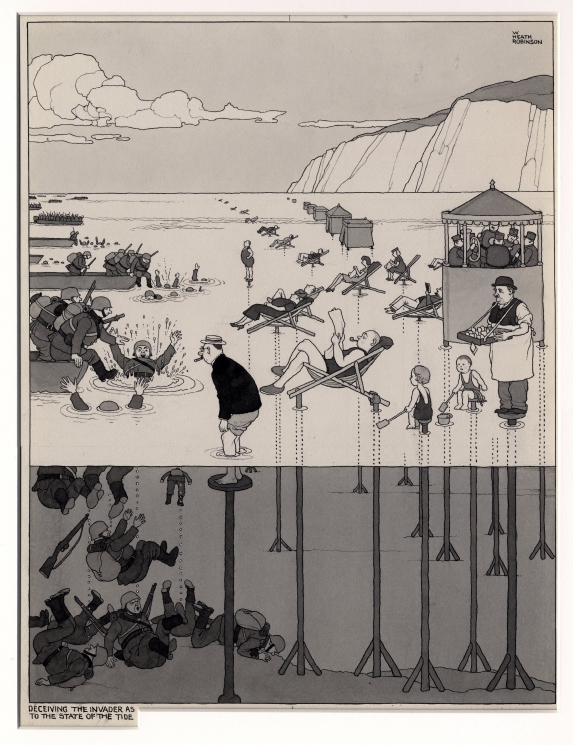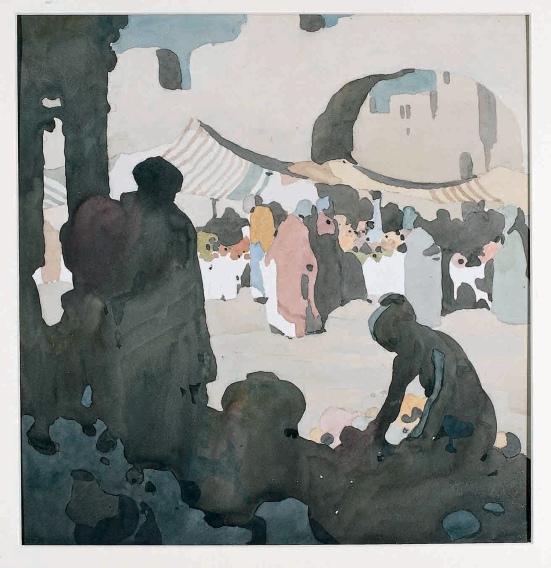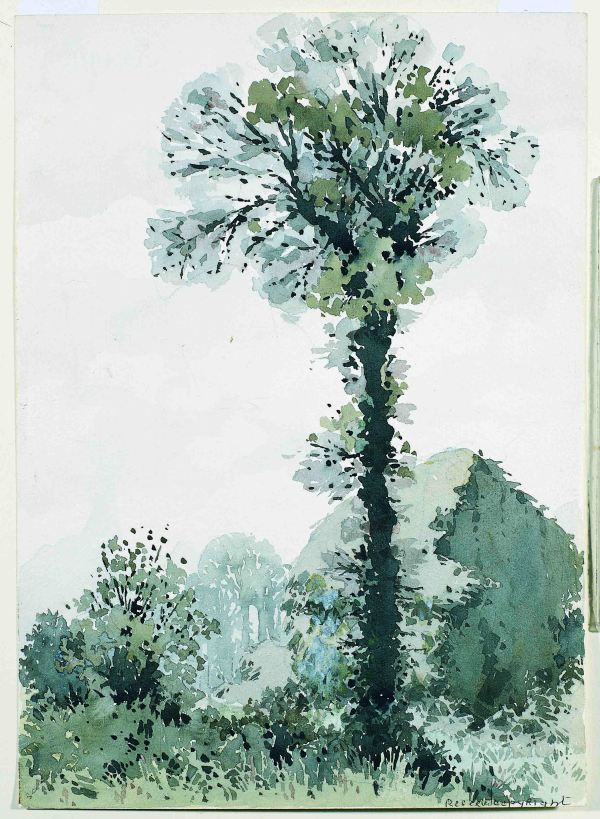The Heath Robinson Museum in Pinner Park, an easy 10-minute walk from Pinner Tube station up the Metropolitan Line, is an unalloyed joy and delight.
The Museum opened in October 2016 and houses some 1,000 artworks by this brilliant and prolific artist, cartoonist and illustrator. Not only is the collection a thing of joy and wonder, but the museum is sited next to an open-air cafe which serves yummy food, both set beside a tree-lined lake in the picturesque Pinner Memorial Gardens. It is a perfect Sunday outing.
Why Pinner? Because Heath Robinson moved here with his young family in 1908, doing much of his best work at a house in nearby Moss Lane, where he is now commemorated by a blue plaque.
Museum layout
The Heath Robinson museum in fact consists of just one main display room but it is an education in itself to witness just how much information can be conveyed in one room. The most interesting feature is the way his life and career is told on a continuous strip extending right round the room at waist height, and undulating and curving a bit like a solidified scroll. This tells HR’s full life story with explanations of key aspects of his career. Some pictures are embedded in the scroll, while above, at head height, is a series of black and white prints, and then over our heads hang a sequence of really large full-colour, poster-size illustrations.

The Heath Robinson Museum showing the waist-level information shelf running round the wall, the mid-height prints, and the high-up colour posters, plus the model contraptions in the middle
There’s an audio guide or commentary. Just tap it against the symbol next to a relevant illustration and it gives a bit of commentary and opinion about it.
And in the centre of the room are some entertaining models of some Heath Robinson contraptions. So although it’s only one room it takes a good 30 to 40 minutes to go round reading everything and looking at everything (and laughing out loud).
Potted biography
William Heath Robinson was born in Finsbury Park in 1872 into a family of artists. His father was an illustrator for newspapers and magazines, and William and his brothers used to copy him as well as drawing things in the family garden and nearby park. Eventually all three brothers became illustrators.
William hankered to be a landscape artist and landscapes remained his first love, but a man needs to eat and, through contacts of his father and brothers, he quickly found work which rewarded his stunning draughtsmanship and eye for detail. From the turn of the century he provided lavish colour illustrations to editions of children’s classics such as Hans Christian Andersen’s Fairy Tales and Legends (1897), The Arabian Nights (1899), Tales from Shakespeare (1902), Gargantua and Pantagruel (1904), Twelfth Night (1908), A Midsummer Night’s Dream (1914) and The Water-Babies (1915). Several of these titles are available in the Museum bookshop as luxurious hardback editions.
The most amazing thing about this picture is that it’s set during the day. The topmost part of the facade opposite is in full daylight – so this isn’t a night-time scene, as the dim darkness suggests – it’s a beautifully poetic evocation of daytime shadow.
In 1909 Heath Robinson was commissioned to illustrate Kipling’s multi-part poem, A Song of the English, written to convey the far-flung nature of the British Empire and the heroism of the men, in particular the sailors, who toiled to preserve it. The pen and watercolour illustrations are quite dazzlingly brilliant.
- ‘The coast-wise lights of England give you welcome back again’ (Song of the English, 1909)
- Sinking ship (Song of the English, 1909)
It’s startling that a man capable of such powerfully visionary pictures could also write and illustrate a children’s book of his own, The Adventures of Uncle Lubin (1902). This is the strange tale of a man who falls asleep minding his baby by a brook only for it to be stolen by the ‘bag-bird’, resulting in a series of adventures to remote picturesque locations like Arabia or the Arctic to try and find the missing babe. Uncle Lubin features in a number of images here, including large poster-size versions of Lubin flying in a typically fraying-string and hand-made balloon.
Contraptions and gadgets
In fact, Uncle Lubin is sometimes regarded as the start of HR’s career in the depiction of unlikely machines – the enormous range of illustrations and cartoon of complicated hand-made contraptions featuring ropes and pulleys, levers and handles, and incongruous household elements like umbrellas and kettles, absurdly and unnecessarily complicated devices erected to carry out incongruously simple or far-fetched activities. It is the mind-boggling array of such devices which gave the language the adjective ‘Heath Robinson’ which can be applied to any absurdly complex and jerry-rigged contraption.

Stout members of the sixth column dislodge an enemy machine gun post on the dome of St Paul’s by William Heath Robinson
Heath Robinson realised that the contraptions are funnier, the more seriously they are taken. Therefore every element of every device is imagined down to the tiniest pulley and knotted string, and all of the army of technicians and engineers and soldiers and scientists are going about their business with the utmost seriousness. He said that the viewer has to believe in the subject as seriously as the characters themselves.
Two World Wars
The market for top end, luxury, lavishly colour-illustrated books dried up with the advent of the Great War. Heath Robinson had been providing comic cartoons for a variety of publications and, when war broke out, began a stream of humorous cartoons satirising the enemy in three books – Some ‘Frightful’ War Pictures (1915), Hunlikely! (1916) and The Saintly Hun: a book of German virtues (1917). All three volumes are collected into one book, available in the bookshop.
Twenty years later, the saintly Hun was back again and Heath Robinson produced another set of war cartoons, this time noticeably satirising official British war efforts. As the commentary points out, maybe the Nazis were just too unspeakable to laugh about.
The war was of course a period of rationing and austerity, with everyone being encouraged to ‘make do and mend’, not throw anything away, but patch and fix things. There’s an obvious link between the increasingly home-made, amateur DIY which the whole population was forced towards, and the relevance and popularity of Heath Robinson’s cracked contraptions.
Cartoons
After the Great War the early lavish illustrations gave way to a flood of humorous drawings for magazines and advertisements. In 1934 he published a collection of his favourites as Absurdities. For example:
- The Wart Chair. A simple apparatus for removing a wart from the top of the head
- Resuscitating stale railway scones for redistribution at the station buffets
You could go a bit heavy and wonder if this between-the-wars interest in absurdity echoes and anticipates the French existentialist emphasis on the absurdity and futility of human existence. The French had Jean-Paul Sartre and the Resistance; we had Heath Robinson and Dad’s Army; the Nazis had the Horst Wessel Song; we had Noel Coward and comic songs like Don’t Let’s Be Beastly To The Germans.
The intellectual summer holiday reminded me of my recent visit to the Wolfgang Tillsman exhibition at Tate Modern, where everyone had their heads stuck in the exhibition pamphlet. Works like Testing teeth typify his deployment of massed ranks of managers and technicians, scientists and supervisors, to give the joke machinery added solemnity and pomposity. They remind me a lot of the government departments where I’ve worked.
Designs for living
The 1930s saw the first big wave of self-improvement books and guides and manuals. Only recently at the British Museum exhibition of landscape watercolours, I was reminded of the Shell guides, written by poets and writers of the day and illustrated by leading artists, which were designed to get the reading public motoring off into the country to explore the counties of England, or pulling on their hiking boots and setting off a-rambling.
It was in this climate that Heath Robinson was paired up with the humourist K.R.G. Browne to illustrate a brilliant series of ‘how to’ books – How to live in a flat (1936), How to be a perfect husband (1937), How to make a garden grow (1938), poking fun at new trends and fashions for ‘modern living’.
In 1933 Heath Robinson did his marvellous cartoon illustrations for the first of the Professor Branestawm books written by Norman Hunter – The Incredible Adventures of Professor Branestawm – which I read and loved as a boy.
Adverts and commercial work
It is also striking to learn that Heath Robinson provided illustrations, straight or comic, for some 100 commercial products, several of which are included here, notably his cartoon-style ads for Hovis bread and some of the humorous illustrations he did for the leather-making firm of Connolly Brothers.
Heath Robinson’s watercolours
But the aspect of his work which I wasn’t expecting and which crept slowly up on me as I walked round, was the strength and power of his more serious work – the early Shakespeare and literary illustrations, for sure, but also the really stunning watercolours and landscapes which he produced throughout his life.
The commentary explains that, quite separately from his commercial work, Heath Robinson continued to paint landscapes in his spare time – sometimes pure pastoral, sometimes with whimsical fairies and goblins, sometimes with more spiritual-looking Greek or idealised human figures ghosting through them.
The cartoons are often very, very funny, all the funnier the more carefully you follow through their ludicrously intricate machinery. But some of these watercolours and spiritualised landscapes are masterpieces in a completely different mood – brilliantly evocative and powerful, strange and haunting.
The commentary points out that Heath Robinson made careful use of deliberately limited tone and palette – the washes come from the same colour base i.e. almost all greens in the watercolour above, variations on blue in the Twelfth Night illustration at the top of this post, more greens in the landscape below. An almost Japanese sense of the unity and harmoniousness of the colours creates a wonderfully dreamlike impression.
As you soak up Heath Robinson’s command of watercolour and the tonal unity of these works, it makes you appreciate all the more how he combined this colour control with the immaculate draughtsmanship so obvious in the cartoons to produce a synthesis – wonderful tonal harmony controlled by breath-taking design – in the best of his fairy, Shakespeare and literary illustrations. And makes you go back to marvel at them all over again.
And, as the exhibition shows, this incredibly diverse artist could also use the same combination in another flavour or style or ‘voice’ altogether – away from the fantastical fairy world, in a style which depicts the modern world with no comic intent but with the same breath-taking linesmanship and colour harmony to create a wonderful sense of warmth and friendliness.
Heath Robinson’s art is at home in the world and makes the viewer, also, feel profoundly, safely at home.
What a really great artist, a brilliant illustrator, a hilarious cartoonist, and a wonderfully evocative watercolourist. This is an absolute treat of a museum!
Credit
All Heath Robinson images reproduced with kind permission of the William Heath Robinson Trust and © The William Heath Robinson Trust.
Related links
- The Heath Robinson Museum, Pinner
- William Heath Robinson Wikipedia article
- BBC News article about the Heath Robinson Museum









